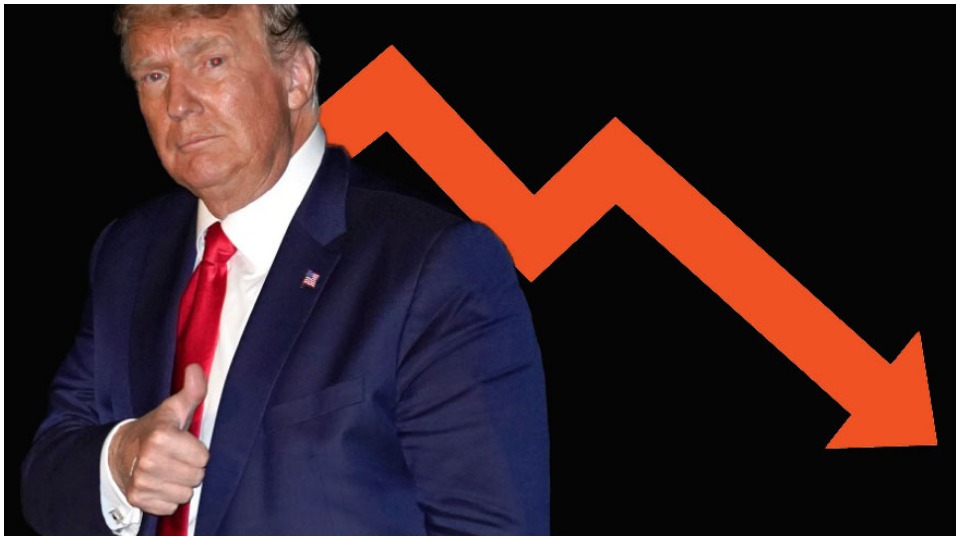
On Thursday, Oct. 29, just five days before the election, the Commerce Department is expected to issue preliminary data showing the U.S. economy grew by around 30% in the third quarter of this year, on an annualized basis. As he seeks to scrape up every vote possible, President Trump can be counted on to claim that this latest data proves his leadership is saving the country from the pandemic-sparked slump and raising the economy from the dead.
He’ll try to make voters who’ve lost their job or seen their small business go belly-up give him one last look before they head to the polls (though given the massive early turnout, there’ll be fewer and fewer to target).
It is indeed true that economic growth on this scale is unmatched in U.S. history. Previously, the best quarter ever was way back in 1950, when there was an annualized gain of 16.7%.
But before anyone is tempted to give Trump or the Republicans any credit, we should examine this 30% number in more detail. A quick look at the situation facing millions of working families—along with some simple arithmetic—will show us right away that the story of “strong growth” just doesn’t add up.
But Trump is hoping we won’t do the math.
We’re still in a depression
The reality remains: This country is in the middle of an economic depression unlike anything seen since the 1930s. Almost 25 million people are still collecting unemployment, and millions more have already been kicked off state aid and are struggling to survive.
The much-hyped growth of the third quarter (July-September) comes right after a disastrous second quarter (April-June), when total output of goods and services in the U.S. plummeted nearly 32%—the most devastating period of collapse ever.
The second quarter was when much of the economy was shut down in an effort to control the coronavirus. People were told to stay home, stores and restaurants closed, schools and universities were shuttered, and travel was restricted. Mass layoffs and bankruptcies followed. The situation got really bad really quick for a lot of people.

Things would have been even worse, of course, without the CARES Act, which included the $600 unemployment supplement, the Paycheck Protection Program, the $1,200 stimulus checks, the student debt moratorium, and other public loan and aid programs—most of which have now expired.
The third quarter, by contrast, saw businesses partially reopen in many parts of the country, and thus a partial revival of economic activity. But that was before the fall months brought a resurgence of COVID and again put the chill on the economy. We’ll only find out the statistics of how bad things are right now with the next report in January.
With coronavirus case counts currently coming in at the 70-80,000+ mark every day and average daily deaths ticking close to 1,000, there is absolutely no reason to expect we will see the economy rebuilt unless there is massive government intervention—something that Trump and Senate Republicans are determined to block.
Some simple math
Just a look around our communities already exposes the lie of a strong economic recovery under Trump, but so do the very statistics he will try to wave in our faces.
Consider those second and third quarter rates again. At first glance, when the economy shrinks 32% in one quarter and then grows 30% in the next, it might look as though we are almost back to where we started. As Trump would say, we are “rounding the corner.” But percentages don’t work that way.
Imagine that our whole economy is worth $100. When we have a 32% decline in one quarter, the economy is now worth $68.
That’s the new base to do calculations for the next quarter. Then we see a 30% growth rate. Doing the math—30% of $68—we get $20.40. So add it up, and we are now at $88.40—and that is only after a year, and only if everything continues improving at the same pace. Every improvement is welcome, but that’s still a long way off from getting back to normal.
These numbers are just for illustrative purposes, but they give an idea of the situation the U.S. is dealing with right now. Inevitably, there was going to be some recovery during the summer months when many states pushed ahead with reopening plans. But there is still a giant hole in the U.S. economy—a hole that threatens to get bigger and suck even more working families into it.
Cloudy statistics

We arrive at such disastrous results even when dealing with the problematic statistics that are used to measure the economy under capitalism, like aggregate GDP. For over 70 years, GDP growth has been the gold standard for governments and international financial institutions when they try to quantify economic activity.
It’s used to decide how much governments can borrow, what their credit rating is, how much money they should be spending on public services like education and health care, and so much more.
But GDP just tells you how much income, or new value (also a problematic notion, but that’s a topic for another article), was created during a particular time period. It tells us nothing about who that value is going to, how it’s being invested, or the social usefulness of the products and services counted. In fact, GDP can be used to hide the answers to all those questions.
Josh Bevins, an analyst with the Economic Policy Institute points out, for instance, that “because the COVID-19 shock has been so centered in low-wage sectors, any given dollar value of GDP lost translates into far more people who have lost jobs.” When economic power is in the hands of a few and gains (and losses) are unequally distributed, GDP growth (or decline) can cover up the extent to which the rich are getting richer or hide the negative impact on workers.
Another way we should be measuring the economy right now is to look at the number of permanent jobs lost, which is different than the official unemployment rate. While a good number of people laid off in April or May have been called back by their employers, the number of workers who are not expected to be re-hired continues to climb every month.
Numbers from the Bureau of Labor Statistics analyzed by the Brookings Institution suggest that nearly four million eliminated jobs are never coming back, and that is almost certainly a major undercount.
When you add these jobs that have evaporated forever to the average number of new jobs we would have expected to be created if the lost year of 2020 was a normal one, then EPI says the U.S. is at least 11 million jobs short of where it needs to be.
Boil it all down, and contrary to what Trump and Republicans claim, the numbers show an economy that is still in dire straits with no clear path to recovery under their management. With the expiration of the CARES Act, things are actually getting worse at this very moment.
Defeat the virus and the depression by defeating Trump
The economy cannot fully reopen and the job situation won’t recover until COVID-19 is brought under control. The administration that occupies the White House, however, has raised the white flag of surrender, announcing this past weekend that it has no intention of reining in the virus.

To make an already awful situation worse, Trump and Republican Senate leader Mitch McConnell refuse to allow a vote on the House-passed HEROES Act. That bill would renew and expand upon the programs of the CARES Act, putting some emergency rescue measures in place to prop up the economy and keep millions more people from falling over the edge.
But the only part of the economy the Trump administration is providing stimulus to right now is the funeral industry. His inaction will lead our coronavirus death toll, already at nearly 230,000, to climb drastically in the coming weeks and months.
If we are ever going to start reversing the deep economic depression we are in, we have to beat the coronavirus pandemic and pass economic rescue packages in Congress that go beyond even the scale of the New Deal during the Great Depression. The HEROES Act is only the start of what’s needed.
Achieving any of this is impossible unless Donald Trump is defeated and GOP control of the Senate is overturned. Nothing less will do.
ELECTION 2020: Everything you need to know to vote in your state
Like free stuff? So do we. Here at People’s World, we believe strongly in the mission of keeping the labor and democratic movements informed so they are prepared for the struggle. But we need your help. While our content is free for readers (something we are proud of) it takes money — a lot of it — to produce and cover the stories you see in our pages. Only you, our readers and supporters, can keep us going. Only you can make sure we keep the news that matters free of paywalls and advertisements. If you enjoy reading People’s World and the stories we bring you, support our work by becoming a $5 monthly sustainer today.












Comments